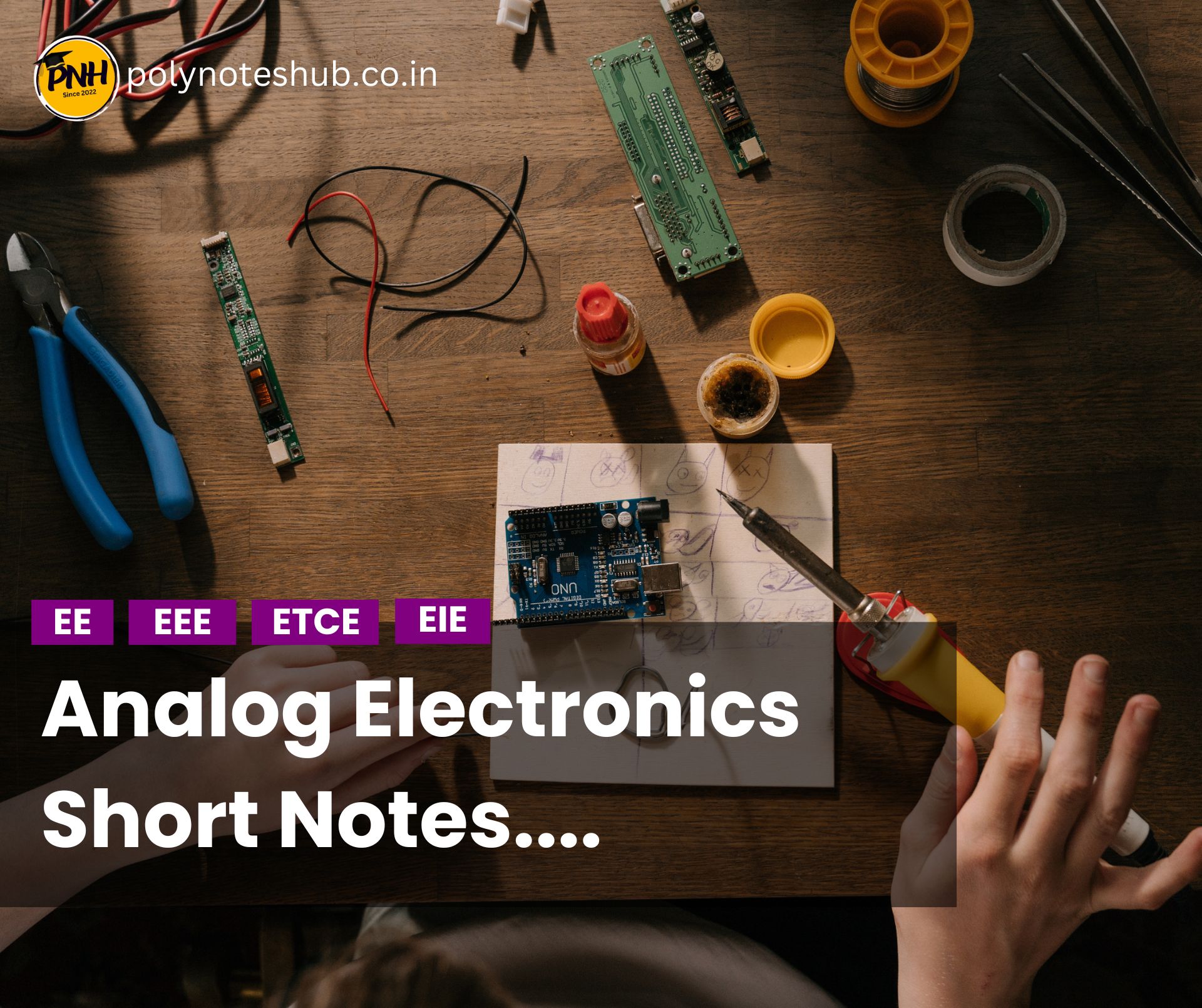On this page, we will review the Analog Electronics Short Notes PDF Part 23. Welcome to Poly Notes Hub, a leading destination for analog electronics notes for engineering students.
Author Name: Arun Paul
Analog Electronics Short Notes Pdf Part 23
Here we have listed some analog electronics short notes for all types of exams like diploma engineering, degree engineering, and GATE exam and many more. In every page, we have listed 10 short analog electronics questions and answers and anyone can download it by a single click for future use.
1. What are the ICs for Voltage Regulations?
ICs for voltage regulation are integrated circuits specifically designed to maintain a constant voltage level. They are used in electronic circuits to provide stable output voltage, protect from voltage fluctuations, and enhance performance. Examples include 78XX, 79XX, LM317, LM337, LM7805, etc.
2. What are the types of Voltage Regulator ICs?
Voltage Regulator ICs are mainly classified into three types:
- Fixed Positive Voltage Regulators
- Fixed Negative Voltage Regulators
- Adjustable Voltage Regulators
3. What are the Fixed Positive Voltage Regulators?
Fixed Positive Voltage Regulators provide a constant positive output voltage. They are from the 78XX series, where “XX” indicates the output voltage.
Examples:
- 7805 → +5V output
- 7812 → +12V output
- 7824 → +24V output
4. What are the Fixed Negative Voltage Regulators?
Fixed Negative Voltage Regulators provide a constant negative output voltage. They belong to the 79XX series.
Examples:
- 7905 → –5V output
- 7912 → –12V output
- 7924 → –24V output
5. What is the Adjustable Voltage Regulators?
Adjustable Voltage Regulators allow you to set the output voltage over a range using external resistors.
Popular examples:
- LM317 → Adjustable positive voltage (1.25V to 37V)
- LM337 → Adjustable negative voltage (–1.25V to –37V)
These regulators are flexible and widely used when a fixed voltage isn’t suitable.
6. What are the limitations of transistorized power supply?
A transistorized power supply uses transistors for voltage regulation and amplification. Its limitations include:
- Power dissipation – Series transistors may heat up and need heat sinks.
- Limited efficiency – More power is lost as heat compared to switching regulators.
- Limited current capacity – Can’t handle very high currents without larger components.
- Component aging – Performance may degrade over time due to thermal stress.
7. What is Glow Tube Voltage Regulator?
A Glow Tube Voltage Regulator is a type of gas-discharge tube (like a neon lamp) used to maintain a constant voltage across a load. It glows and conducts at a specific voltage.
8. What is Negative Feedback Voltage Regulator?
A Negative Feedback Voltage Regulator controls its output voltage using feedback. If output voltage increases, the feedback decreases it, and vice versa. This creates a stable and regulated output, improving accuracy and reducing ripple.
9. Explain Glow Tube Voltage Regulator Operation?
In a Glow Tube Voltage Regulator, a gas-filled tube (like a neon bulb) is connected across the load. Here’s how it works:
- When the input voltage rises above a certain threshold (called the ionization voltage), the gas inside the tube ionizes and begins to conduct.
- It glows and maintains a constant voltage across itself by absorbing the excess voltage.
- If the input voltage falls below the ionization point, the tube stops conducting.
10. What are the limitations of unregulated power supply?
An unregulated power supply directly converts AC to DC without maintaining a steady output voltage. Its limitations include:
- Poor voltage regulation – Output voltage varies with load or input changes.
- No protection – No short circuit or overvoltage protection.
- Ripple and noise – High ripple content affects sensitive circuits.
- Unreliable for precise devices – Not suitable for microprocessors or digital electronics.

